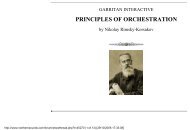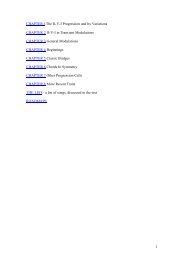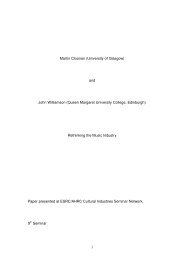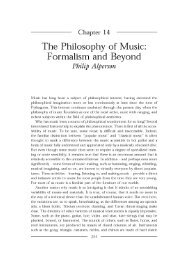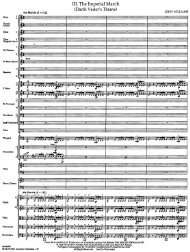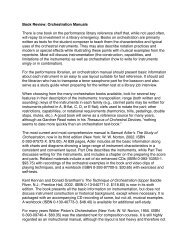TWENTIETH- - Synapse Music
TWENTIETH- - Synapse Music
TWENTIETH- - Synapse Music
Create successful ePaper yourself
Turn your PDF publications into a flip-book with our unique Google optimized e-Paper software.
214 Classical Serialism<br />
SUMMARY<br />
The pitch materials of a serial work are derived from the twelve-note row, so an<br />
analysis should begin with the row itself. Two special types of row are derived sets<br />
and all-interval sets. A composition may make use of the prime row, its retrograde.<br />
its inversion. and its retrograde inversion, each of which can appear at any of twelve<br />
transpositions. This pitch material may be conveniently displayed in the form of a<br />
matrix.<br />
Row forms may be used compositionally in a number of ways. For example, a<br />
single row form may be distributed among the voices, or more than one row form<br />
may be used at the same time. The choice of row forms is often related to invariance<br />
or combinatoriality, among other reasons.<br />
Analysis of serial music includes identification of the row fanns and consideration<br />
of the reasons for choosing a particular row form and transposition, but a thorough<br />
analysis cannot be confined only to serial matters.<br />
NOTES<br />
1. Jan Maegaard, "A Study in the Chronology of Op. 23-26 by Arnold Schoenberg." See<br />
the chart on p. 108.<br />
2. Another approach (and one that was used in previous editions of this book) labels the<br />
first appearance of the row as P-O, no matter what pitch class it begins with, and numbers<br />
the transpositions chromatically from that pitch class. Also, some authors have<br />
employed the letters S or 0 instead of P for the prime form of the row.<br />
3. Another type of all-interval row contains all of the intervals only if some of them are<br />
ascending and others are descending. The Dallapiccola row discussed in this chapter is<br />
one example.<br />
4. The so-called "hexachord theorem." See John Rahn, Basic Atonal Theory, p. 105.<br />
EXERCISES<br />
Part A: Fundamentals<br />
I. Suppose P-7 begins on G and ends on Bb:<br />
Form Begins on Ends on<br />
(a) P-6<br />
(b) P-ll<br />
(c) R-O<br />
(d) R-5<br />
(e) 1-1<br />
(f) 1-9<br />
(g) RI-2<br />
(h) RI-7



